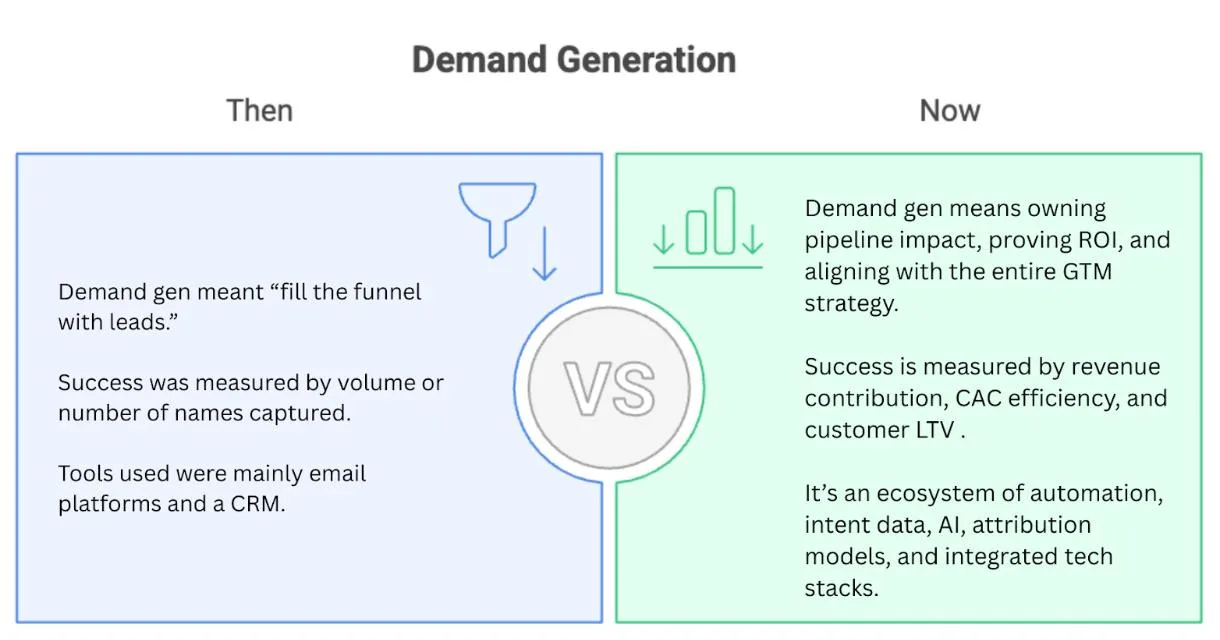Demand Generation Job Description: A Blueprint for B2B Marketing Success
As B2B markets grow increasingly competitive, the role of Demand Generation has become one of the most critical drivers of sustainable growth. The right Demand Generation professional does far more than run campaigns. They align marketing with sales, orchestrate cross-channel programs, and deliver measurable pipeline impact that accelerates revenue.
If you’re hiring for this role, or considering it as your next career step, here’s what the job really looks like in 2025.
What is Demand Generation?
At its core, demand generation is about creating a predictable, scalable pipeline for the business. Demand gen leaders design strategies that attract the right prospects, nurture them through the buyer journey, and convert them into sales-ready opportunities.
A decade ago, demand gen was often equated with lead generation activities like blast an email list, gate a whitepaper, and hand names to sales. That playbook doesn’t work anymore. Today’s buyers are already halfway through their research before they even talk to a rep. Demand gen leaders know how to meet them earlier, nurture them with meaningful content, and keep the entire journey connected from first touch to closed deal.
Think of demand gen as both architect and conductor: setting up the blueprint for growth, then orchestrating the channels, content, and teams that bring it to life.
What Demand Generation Role Looks Like Today
The job is broad and demanding, but that’s what makes it central to growth. Here’s what demand gen professionals are expected to do and the skills they bring to make it happen.
Designing Campaigns That Work Across Channels
It’s not enough to run one good email program. Today’s demand gen leader thinks across the entire mix: paid search, LinkedIn ads, webinars, SEO, content syndication, even in-person events. The craft lies in weaving them into integrated campaigns that consistently deliver qualified pipeline.
Turning Data Into Decisions
This role is built on analytics. From understanding funnel conversion rates to calculating CAC payback, demand gen pros need to be fluent in numbers. They live inside Salesforce dashboards, marketing automation reports, and attribution models, not just to report results, but to know where to double down and where to cut.
Working Hand-in-Hand with Sales
Marketing can’t operate in a vacuum anymore. A modern demand gen pro sits at the table with sales leaders, ensuring that leads are qualified, handoffs are seamless, and campaigns are built with revenue in mind. This collaboration is what separates activity from real impact.
Owning the Nurture Journey
Not every prospect is ready today. That’s why nurture programs, emails, guides, case studies, webinars, are so critical. A demand gen leader makes sure prospects keep engaging until they’re sales-ready, personalizing touchpoints along the way.
Adopting the New Playbook
From account-based marketing (ABM) to product-led growth (PLG) motions, to AI-powered targeting, demand gen is constantly evolving. Professionals in this field are expected to test new channels, experiment with new tactics, and bring curiosity into every campaign.
How the Role Has Changed
If you compare today’s job postings to those from ten years ago, the shift is apparent. the role has matured from tactical campaign runner to strategic growth driver.

Ten years ago, demand generation focused on filling the funnel, measuring success by the number of leads captured, and relying on basic tools like email and a CRM. Today, the role is accountable for pipeline impact, ROI, and GTM alignment. Success is judged by revenue contribution, CAC efficiency, and customer lifetime value, supported by advanced tools such as marketing automation, intent data, AI, attribution models, and integrated tech stacks.
The Strategic Impact of Demand Generation
In B2B marketing, where buyer journeys are long and competition is fierce, demand generation has become the engine of growth. By uniting strategy, data, and execution, Demand gen professionals fuel predictable pipeline, enable revenue teams, and directly impact business outcomes. For organizations, investing in this role delivers measurable ROI and faster growth. For professionals, it represents a career path at the center of modern B2B marketing strategy.
Inflection is built to support this shift. Inflection helps B2B and AI-native companies drive pipeline and growth across the account lifecycle. By unifying data through the ContextGraph, Inflection powers demand generation, onboarding, and expansion with the intelligence and automation teams need to deliver measurable impact. Request a demo today.
%201.webp)





